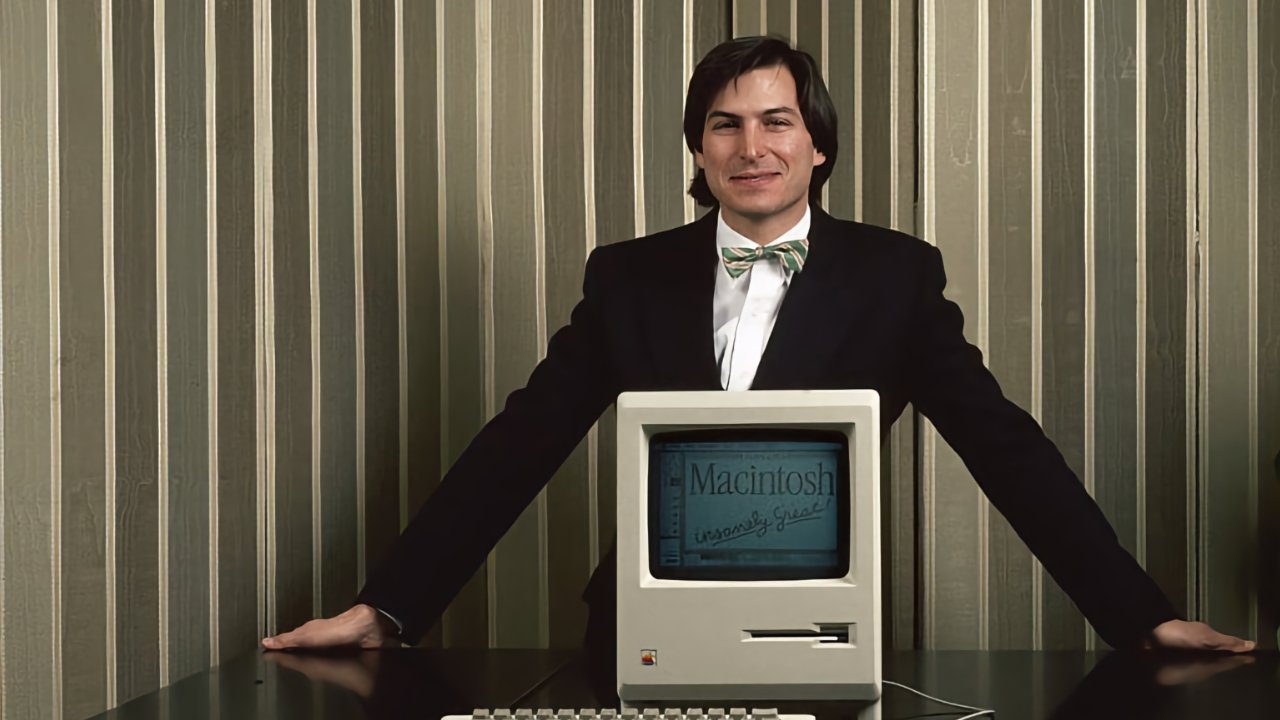Steve Jobs with the original Macintosh, created eight years after Apple's founding
 37 Facebook x.com Reddit
37 Facebook x.com Reddit
The Apple of 1976 is unrecognizable compared to today's giant corporation, and yet the key early decisions of Steve Jobs, Steve Wozniak and many others still have an effect today.
Tim Cook marked Apple's 45th anniversary with a tweet remembering his friend and fellow co-founder Steve Jobs.
Today, as Apple celebrates its 45th anniversary, I am reminded of what Steve said many years ago: “It was an amazing journey, but we have barely begun.” Thank you to every member of our Apple family for everything you have done to make life better. Over the next 45 years & beyond!
— Tim Cook (@tim_cook) April 1, 2021
Tim Cook, now a renowned CEO, originally joined Apple in 1998 to work on how the company physically managed manufacturing and distribution. The company was 22 years old at the time, and with Jobs' return it began to revive.
So it has already had growing pains, but it has not yet become the powerhouse it will become.
The history of Apple in three acts
Today, Apple is undoubtedly in the third act of its history. Back in the 1970s, it had a thrilling first act, then endured a chaotic second act in the 1990s, before eventually becoming a textbook American success story. It was true — You can start a multi-trillion dollar multinational company in a garage.
However, creating a company was not an obvious step at all. In the mid-1970s, Steve Wozniak had designs for what became known as the Apple I computer, and his friend Steve Jobs planned to sell them. Woz would have given them away to anyone who wanted them, Jobs wouldn't, and even so, even the much more commercially minded Steve Jobs had no intention of starting a company.
Instead, both Steves first tried to sell their ideas to existing firms that they either worked for at the time or had previously worked for. Woz was an engineer at Hewlett-Packard, for example, and he managed to convince senior engineers to study his design so that HP would buy them.
They not only agreed that it was feasible, but also recognized that it could be done cheaply – — and yet they passed it on. Woz's ideas did not correspond to what they thought the Hewlett-Packard computer should be.
Steve Jobs' old firm Atari felt the same way. He tried to interest Atari in what would become the Apple II, but that too was rejected. Except Atari's Al Alcorn connected Jobs with venture capitalists, and the path to founding the company began.
When they officially founded Apple, it was with another Atari engineer, Ron Wayne. He famously designed the original, extremely ornate Apple logo and then, even more famously, left the company before it even took off. He just left even faster than you could imagine.
The three officially founded Apple on April 1, 1976, with Ron Wayne resigning just 12 days later. He was offered ten percent of Apple's shares, but instead chose to be bought out by Steve Jobs for $800.
Although stock prices obviously vary widely, if you look at March 2023, Wayne's $800 is equivalent to just five individual shares of the company.
However, this payment would later be increased, since in 1977 a much more experienced businessman, Mark Markkula, joined us as an investor. Under Markkula, Apple officially bought out all three original partners for a total of $5,308.96. For legal reasons, Wayne received a third of this amount, despite the fact that he had already left.
The original founders of Apple. From left to right: Steve Wozniak, Steve Jobs, Ron Wayne
It's impossible now not to view his departure as a mistake, given Apple's overwhelming success. But he was being paid reasonably at the time and was leaving a firm with an uncertain future. Ron Wayne was asked countless times about his retirement, but in 2013 he said he had no regrets.
“I consider myself extremely fortunate to be at a turning point in history,” he said, “and the creation of Apple was truly a turning point in history, although at the time, of course, no one ever knows that.”
Apple's first success
After he left, but before Markkula turned it into an adult company, Apple achieved its first success — and it will seem familiar if you watch how the company operates today. Apple produced 50 Apple-I computers with no money at all, and sold them all the day before it had to pay its suppliers.
Today Apple has an extremely well-managed approach to its supply chain, but even in 1976 it literally understood the benefits of finance. This was the first time Steve Jobs heard of the so-called 30-day net term, meaning you have that much time to pay your suppliers. He learned it then because he had to.
Jobs proposed Apple-I to Paul Terrell, who then ran the successful Byte Shop company. While Jobs wanted to sell motherboards and kits so hobbyists could build their own computers, Terrell wanted assembled devices, and he got them.
If Apple learned about finance and supply chains then, it learned about business in 1977, when former Intel employee Markkula joined it. However, in addition to reorganizing the business, he did something else that remains part of Apple all these decades later.
He outlined the company's philosophy.
It's probably part of Business 101 at Harvard that corporations need philosophies and mission statements, and if you've ever worked in a corporation, you've probably viewed them with a healthy skepticism. In Apple's case, however, the philosophy Markkula laid out was remarkably clear, and the company stuck to it remarkably consistently.
It was Apple in 1977 – and it is still Apple today.
Steve Jobs later explained to his biographer Walter Isaacson that Markkula's idea was is that money should not be the goal. You obviously need to do it, and it's even more obvious that you want to do it, but if money comes first, the company will struggle. And if you do “what you believe in” and also focus on “building a company that lasts,” the money will come.
Markkula's “Apple Marketing Philosophy” is clearly Apple's because it is extremely and deliberately simple. The one-page document, written on January 3, 1977, contains only two short directives about understanding customer needs and focusing on a few specific products rather than spreading information too thin.
It then concludes with a paragraph dedicated to communicating information about Apple to its customers.
People DO judge a book by its cover. We may have the best product, the highest quality, the most useful software, etc.; if we present them carelessly, they will be perceived as sloppy; if we present them creatively, professionally, we will impart the desired qualities.
To this day, Apple is known for how well it presents its products and how carefully the packaging is designed. Today, it's still part of what makes Apple Apple.
And this has been written into the company since its inception. It was a mission statement back then, but by the end of Steve Jobs' life it was an entire “packing room” where boxes were developed and tested.
In its 48th year, the company's focus on packaging is perhaps even stronger. Apple has pledged to eliminate all plastic packaging by the end of 2024, just in time for the company's 50th anniversary.
Follow AppleInsider on Google News.









